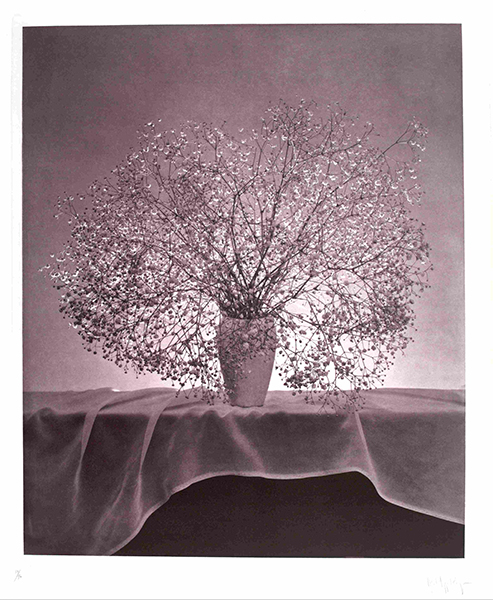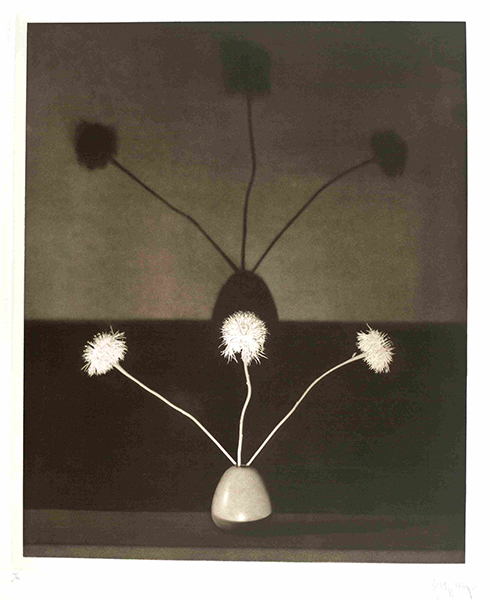Pride Month 2022: Robert Mapplethorpe
Part of a glittering gay culture of New York in the late 1970s and 1980s, Robert Mapplethorpe is most remembered for his photographs of male nudes. However, his body of work was not restricted to any one subject, and his late work with flowers has perhaps gained as much attention as his nude works since his untimely death. Through lighting, composition, and use of the photogravure medium, Mapplethorpe’s Flowers portfolio is beautiful in its stunning simplicity of conception.
 |
| Robert Mapplethorpe (1946–1989, U.S.), Untitled, from the Flowers portfolio, 1983. Photogravure and chine collé on rag paper, 31 ½" x 25" (80.01 x 63.5 cm). Courtesy of the Albright-Knox Art Gallery, Buffalo, NY. © 2022 Artist or Estate of Artist. (AK-701B) |
Mapplethorpe's earliest floral still-life photographs date to 1973, not long after he was given a Polaroid camera by his friend John McKendry (1933–1975), who was curator of prints and photographs at the Metropolitan Museum of Art in New York. Early floral works taken with the Polaroid were shot with sepia filters to simulate 1800s still-life photographs, of which Mapplethorpe was also a collector. In 1977, he acquired a Hasselblad camera, a square-format camera with which he introduced black-and-white floral still-life works such as this untitled work.
Floral still-life works such as Untitled are comparable compositionally to Mapplethorpe's nudes, particularly in black-and-white. They reflect the same celebration of simplified studies of form as his nudes. The artist continued his long-term exploration of dramatic lighting with sharp shadows.
The floral arrangements are almost always photographed on a blank background, like his nudes, and the careful attention to lights and darks across the surface of the flowers lends them a sensuality equal to that of his nudes. They definitely have the same focus of subject as Dutch Baroque floral still-life paintings. The shelf ledge with shadow draped over it abuts the picture plane much the way late-1800s American trompe-l'oeil still-life paintings do.
Still-life photographs date back to the earliest experiments of Louis Daguerre (1787–1851) and Henry Fox Talbot (1800–1877). Still life was a favored subject because of the long exposure times required in early photography, often as long as 30 minutes. It existed as a stand-alone subject along with portraiture and landscape through the 1800s. In the early 1900s, the Art Photography (Pictorialism) movement nurtured the development of still life influenced by Dutch Baroque still-life painting, including dramatic lighting and soft focus that imitated painting.
The trend toward artistically (rather than documentary) photographed still life was amplified in a modern way during the 1920s and 1930s with Dada and Surrealism. Artists such as Man Ray (1890–1976) depicted still-life objects that evoked symbolism on the human condition. In the 1980s, Mapplethorpe renewed the symbolic still life in a contemporary manner.
Mapplethorpe was born in Queens, New York, and studied drawing, painting, graphic design, and sculpture at the Pratt Institute in Brooklyn. Early influences on his work were the found-object and collage works of Joseph Cornell (1903–1972) and Marcel Duchamp (1887–1968). His early work featured mixed-media collages using cutouts from magazines and books, as well as found object combinations. Soon after receiving his Polaroid camera, he began replacing the cutouts with Polaroids he took.
The artist quickly learned that photography was his medium of choice and began concentrating on his Polaroids as stand-alone works of art. He built his photographic career on portraits of a variety of public personalities, including designed album covers and the portraits and party photographs in Interview Magazine. By the late 1970s, with his body of work established, he began to explore photographing male and female nudes in a provocative manner. Despite the controversy caused by the nudes, he became established in a gallery by 1978, and participated in shows both in the U.S. and Europe.
With Mapplethorpe’s controversial nude studies, the artist refined his techniques of composition and lighting. He explored and refined novel formats and techniques, including 20" x 24" (50.8 x 61 cm) Polaroids, photogravures, platinum prints on paper and linen, Cibachrome, sepia, and dye-transfer prints. Through the 1980s, Mapplethorpe produced series of images that both challenged and remained within aesthetic traditions, including portraits of celebrities of all genres, nudes, and floral still life in both color and black-and-white.
Another work from the Flowers portfolio:
 |
| Robert Mapplethorpe, Untitled, from the Flowers portfolio,1983. Photogravure with chine collé on rag paper, 31 ½" x 25" (80.01 x 63.5 cm). Courtesy of the Albright-Knox Art Gallery, Buffalo, NY. © 2022 Artist or Estate of Artist. (AK-701G) |
Correlations to Davis programs: The Visual Experience 4E: 4.4; Focus On Photography 2E: Chapter 8; Exploring Visual Design 4E: Chapter 9


Comments